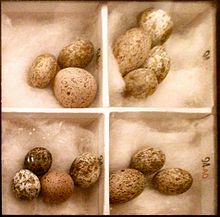Pattern mimicry through a birds eye
The Cuckoo bird is a brood parasite, this means that it lays its eggs inside the nest of another bird, the other bird then feeds and nurtures the eggs of the Cuckoos.
This parasitism has caused both of the species involved to evolve further. The birds have evolved to notice when their nest has been parasitised. However the cuckoo has evolved to have egg mimicry. This study I am blogging about is going to explore this(Stoddard and Stevens, 2010).
The study found that the cuckoos eggs were evolved to mimic in the species which rejected the eggs the most. They are in an evolutionary arms race always changing to beat each others defenses. The study found that there was no pattern on the egg which has no rejection. One of the main issues is the markings sizes. The host is less likely to reject the egg if the marking sizes are the same. Some host species such as the Australian bronze-cuckoo do not reject the eggs even though they are darker. This could be due to the eggs being camouflaged in the nest(Stoddard and Stevens, 2010).

Figure 1: Cuckoo eggs on top mimicing the Reed warbler eggs bottom (Chap, 2012).
References
Chap, C. (2012). [image] Available at: http://en.wikipedia.org/wiki/Common_cuckoo#/media/File:Cuckoo_Eggs_Mimicking_Reed_Warbler_Eggs.JPG [Accessed 9 May 2015].
Stoddard, M. and Stevens, M. (2010). Pattern mimicry of host eggs by the common cuckoo, as seen through a bird's eye. Proceedings of the Royal Society B: Biological Sciences, 277(1686), pp.1387-1393.








